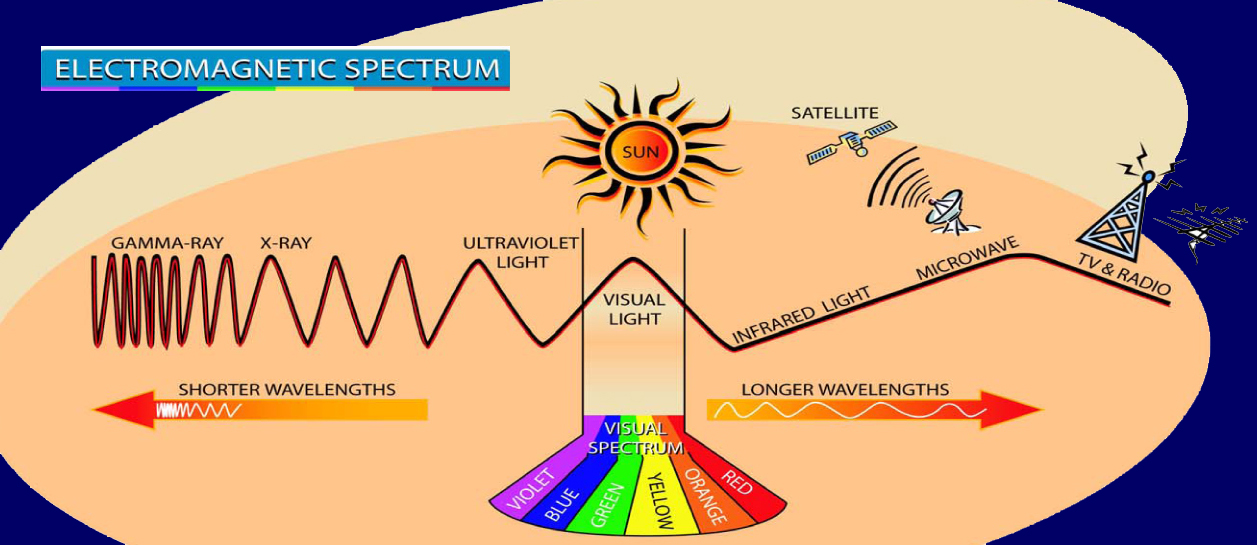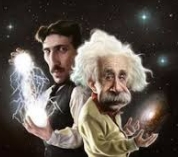< previous -
1 - 2 - 3 -
4
- next
>
Ed's
AV Handbook
Chapter
2 Page 3
AV Physics

Ed's
AV Handbook
Batting Practice for the AV Professional
and primer for the novice
Chapter
2 Page 3
AV Physics
Electromagnetic Energy

Electromagnetic energy is
the compression and rarefaction of waves of magnetic-fields
and electric-currents traveling through the vacuum of
space or atmospheres of planets. The sun is a source of
electromagnetic energy. The sun generates
magnetic-fields that discharge electric-currents, which
produce magnetic-fields that discharge
electric-currents. This is the compression-rarefaction
cycle of electromagnetic energy.
The electromagnetic spectrum includes gamma rays, x-rays, ultraviolet light, visible light, infrared light-heat, microwaves, and radio. Visible light and radio occupy a small fraction of the electromagnetic spectrum.
As sound and the ocean wave, wavelength, frequency, amplitude, and subjective intensity (if applicable) also describes electromagnetic energy.
The electromagnetic spectrum includes gamma rays, x-rays, ultraviolet light, visible light, infrared light-heat, microwaves, and radio. Visible light and radio occupy a small fraction of the electromagnetic spectrum.
As sound and the ocean wave, wavelength, frequency, amplitude, and subjective intensity (if applicable) also describes electromagnetic energy.
Handbook
Note:
Nano = one billionth or 1/1,000,000,000
Trillion = 1,000,000,000,000
Nano = one billionth or 1/1,000,000,000
Trillion = 1,000,000,000,000

Visible Light
Visible light is the compression
and rarefaction of visible-electromagnetic waves. An
initiating disturbance such as the sun or an artificial light
source starts the cycle of visible electromagnetic
energy. The electro-magnetic-cycle continues until it
terminates in our eyes or fades away.
White light projected through a prism separates into a rainbow of all the colors of visible light.
- The wavelengths of visible light range
White light projected through a prism separates into a rainbow of all the colors of visible light.
- The wavelengths of visible light range
from 400nm to
700nm.
- The wavelength of the
color red is 570nm, green 540nm, blue 440nm.
- Invisible light with wavelengths
shorter than 400nm is the ultraviolet spectrum.
- Wavelengths longer than
770nm is the infrared spectrum.
The frequency of light measures in the trillions of cycles per second. A frequency range of 400 to 750 trillion cycles per second. Note, this is a very narrow range when compared to the ten-octave range of the ear.
The amplitude of light is its intensity, measured by its directional radiating power of luminance. Luminance, measured in units of the lumen, ranges from 0 to more than 12000 lumens.
Use the following as a reference:
- The amplitude of Indoor artificial light ranges
from 400 to 600 lumens.
- Outdoor brightness ranges
from 1000 to 12000 lumens.
- Our eyes are comfortable to about 3,500 lumens.
- 4,000 lumens becomes glare.
- At 10,000 lumens our eyes block light.
- 12,000 lumens is the amplitude of snow blindness.
The subjective intensity of the light to the human eye is brightness. Brightness is to light as loudness is to sound. As the ear to sound, the eye is not equally sensitive to the entire bandwidth of light. It is very sensitive to the wavelength of green light, less sensitive to red light, and even less to blue light. Furthermore, the amplitude of light creates two states of vision - scotopic and photopic.
The scotopic state is our adapted night vision. It involves the rods of the eye's retina, which are very sensitive to the intensity of light.
But their sensitivity is limited to the shorter blue colored wavelengths.
The photopic daylight state involves the cones of the eye's retina,
which are very sensitive to the entire spectrum of color while much-less sensitive to the intensity of light.
Handbook Note:
Speed of light and radio = 186,000 miles/second
Speed of sound = 1130ft/second
- The wavelength of the
color red is 570nm, green 540nm, blue 440nm.
- Invisible light with wavelengths
shorter than 400nm is the ultraviolet spectrum.
- Wavelengths longer than
770nm is the infrared spectrum.
The frequency of light measures in the trillions of cycles per second. A frequency range of 400 to 750 trillion cycles per second. Note, this is a very narrow range when compared to the ten-octave range of the ear.
The amplitude of light is its intensity, measured by its directional radiating power of luminance. Luminance, measured in units of the lumen, ranges from 0 to more than 12000 lumens.
Use the following as a reference:
- The amplitude of Indoor artificial light ranges
from 400 to 600 lumens.
- Outdoor brightness ranges
from 1000 to 12000 lumens.
- Our eyes are comfortable to about 3,500 lumens.
- 4,000 lumens becomes glare.
- At 10,000 lumens our eyes block light.
- 12,000 lumens is the amplitude of snow blindness.
The subjective intensity of the light to the human eye is brightness. Brightness is to light as loudness is to sound. As the ear to sound, the eye is not equally sensitive to the entire bandwidth of light. It is very sensitive to the wavelength of green light, less sensitive to red light, and even less to blue light. Furthermore, the amplitude of light creates two states of vision - scotopic and photopic.
The scotopic state is our adapted night vision. It involves the rods of the eye's retina, which are very sensitive to the intensity of light.
But their sensitivity is limited to the shorter blue colored wavelengths.
The photopic daylight state involves the cones of the eye's retina,
which are very sensitive to the entire spectrum of color while much-less sensitive to the intensity of light.
Handbook Note:
Speed of light and radio = 186,000 miles/second
Speed of sound = 1130ft/second
Invisible Radio
Radio is the compression and
rarefaction of invisible electromagnetic waves of
energy. The disturbance of radio broadcast antenna
"sparks" initiate this cycle. The cycle terminates at a
receiving antenna or fades away.
A radio broadcast begins with the continuous controlled spark of a modulating electric current in a copper wire of a broadcast antenna. The modulating current of electrical spark generates cycles of electromagnetic waves. The sparking-waves cause electrons in a receiving antenna to budge, dislodge, and regenerate new radio cycles of electromagnetic current.
Broadcast radio covers a frequency range of thousands of cycles per second as AM radio to billions of cycles per second as satellite TV.
The typical car radio displays the broadcast frequency on its front panel -- AM in kHz and FM in MHz.
The wavelength of radio ranges from a few hundred yards as AM radio to a fraction of an inch as satellite TV.
The power or amplitude of radio's electromagnetic energy, measured in watts, is equal to the flow of electrical current in amps multiplied by its pressure in volts.
A subjective response to electromagnetic radio does not apply as it did with sound and light because humans cannot see or hear electromagnetic radio waves.
Don't change that channel. We will return to the exciting conclusion of radio in chapter 3 following these messages. Please stay tuned.
< previous - 1 - 2 - 3 - 4 - next >
A radio broadcast begins with the continuous controlled spark of a modulating electric current in a copper wire of a broadcast antenna. The modulating current of electrical spark generates cycles of electromagnetic waves. The sparking-waves cause electrons in a receiving antenna to budge, dislodge, and regenerate new radio cycles of electromagnetic current.
Broadcast radio covers a frequency range of thousands of cycles per second as AM radio to billions of cycles per second as satellite TV.
The typical car radio displays the broadcast frequency on its front panel -- AM in kHz and FM in MHz.
The wavelength of radio ranges from a few hundred yards as AM radio to a fraction of an inch as satellite TV.
The power or amplitude of radio's electromagnetic energy, measured in watts, is equal to the flow of electrical current in amps multiplied by its pressure in volts.
A subjective response to electromagnetic radio does not apply as it did with sound and light because humans cannot see or hear electromagnetic radio waves.
Don't change that channel. We will return to the exciting conclusion of radio in chapter 3 following these messages. Please stay tuned.
< previous - 1 - 2 - 3 - 4 - next >
Ed's AV
Handbook
Copyright 2007 Txu1-598-288 Revised 2025
Copyright 2007 Txu1-598-288 Revised 2025
Architectural
Speaker Tuning System
for
in-wall/ceiling custom installed speakers.
Reclaim the performance you paid for.
Site Menu
Home
Table of
Contents
Handbook Chapters
1 AV
Terms
2 AV Physics
3 Sound Reproduction
4 Video Reproduction
5 The AV System Sequence
6 The Room, Speaker, & TV
7 Acoustical Strategy - Small Room
8 Home Theater by Design
9 AV Sales Training
10 AV Business & Marketing
Contact
About
